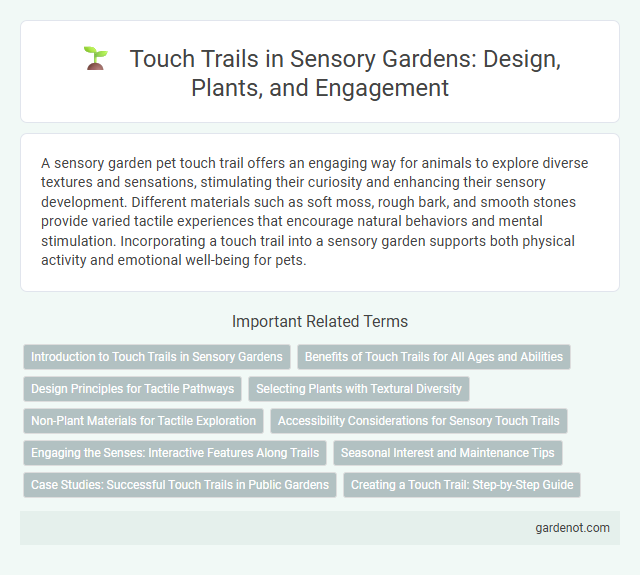A sensory garden pet touch trail offers an engaging way for animals to explore diverse textures and sensations, stimulating their curiosity and enhancing their sensory development. Different materials such as soft moss, rough bark, and smooth stones provide varied tactile experiences that encourage natural behaviors and mental stimulation. Incorporating a touch trail into a sensory garden supports both physical activity and emotional well-being for pets.
Introduction to Touch Trails in Sensory Gardens
Touch trails in sensory gardens provide an interactive pathway designed to engage visitors through tactile experiences. These trails incorporate a variety of textured materials and natural elements such as bark, leaves, and stones to stimulate the sense of touch. By exploring different surfaces and shapes, touch trails promote sensory development, especially for children and individuals with sensory processing needs.
Benefits of Touch Trails for All Ages and Abilities
Touch trails in sensory gardens offer inclusive opportunities for tactile exploration, benefiting individuals across all ages and abilities by enhancing sensory awareness and fine motor skills. These trails stimulate neural pathways through varied textures, promoting cognitive development and emotional well-being. Accessible design elements ensure that touch trails support rehabilitation, learning, and relaxation for children, adults, and seniors alike.
Design Principles for Tactile Pathways
Design principles for tactile pathways in sensory gardens emphasize varied textures, elevations, and materials to engage multiple receptors on the skin, enhancing sensory integration and spatial awareness. Pathways incorporate natural elements such as bark, sand, pebbles, and smooth stones arranged in rhythmic patterns to maximize tactile stimulation and promote exploratory interaction. Safety and accessibility are prioritized through non-slip surfaces and clear edge delineations, ensuring inclusive usability for individuals with different tactile sensitivities and mobility needs.
Selecting Plants with Textural Diversity
Selecting plants with varying leaf textures such as soft lamb's ear, spiky ornamental grasses, and rough barked shrubs enhances the tactile experience along the touch trail in a sensory garden. Incorporating diverse plant textures like velvety moss, prickly cacti, and smooth succulents stimulates different sensory responses and encourages mindful exploration. Prioritizing plants with contrasting tactile qualities supports accessibility and engagement for visitors with different sensory preferences.
Non-Plant Materials for Tactile Exploration
Touch trails in sensory gardens incorporate non-plant materials such as smooth stones, textured fabrics, and wooden carvings to enhance tactile exploration. These materials provide diverse sensory feedback, stimulating different nerve endings and improving sensory processing skills. Incorporating varied textures supports cognitive development and offers inclusive experiences for visitors with tactile sensitivities or disabilities.
Accessibility Considerations for Sensory Touch Trails
Sensory touch trails in gardens enhance accessibility by incorporating tactile elements designed for individuals with diverse sensory needs, including varying textures, materials, and interactive features that engage the sense of touch. Clear signage with braille and high-contrast visuals supports navigation for visitors with visual impairments, while smooth, stable pathways ensure wheelchair accessibility and safe exploration. Integrating sensory zones with varying touch stimuli promotes inclusive experiences, fostering connection with nature for all users.
Engaging the Senses: Interactive Features Along Trails
Touch trails in sensory gardens create immersive experiences by incorporating diverse textures such as rough bark, smooth stones, and soft moss, stimulating tactile exploration. Interactive features including textured panels, raised patterns, and natural materials invite visitors to engage sensory perception actively. These carefully designed elements enhance cognitive connection to nature, promoting sensory development and relaxation.
Seasonal Interest and Maintenance Tips
A touch trail in a sensory garden offers year-round tactile engagement by incorporating plants with varied textures that change with the seasons, such as soft lamb's ear in spring, rough ornamental grasses in summer, and crisp, textured seed pods in autumn. Regular maintenance includes pruning to prevent overgrowth, removing dead leaves to enhance texture visibility, and rotating seasonal plants to maintain vibrant sensations throughout the year. Consistent monitoring ensures the trail remains accessible and safe, encouraging continuous sensory exploration.
Case Studies: Successful Touch Trails in Public Gardens
Successful touch trails in public gardens, such as the Royal Botanic Gardens in Kew and the Chicago Botanic Garden, demonstrate enhanced visitor engagement through tactile plant labels, textured pathways, and interactive exhibits designed for diverse sensory experiences. These case studies highlight the importance of integrating multisensory elements that cater to both visually impaired visitors and the general public, promoting accessibility and educational value. Data from visitor feedback and participation rates confirm that well-designed touch trails increase both visitor satisfaction and time spent exploring garden features.
Creating a Touch Trail: Step-by-Step Guide
Creating a touch trail in a sensory garden involves selecting diverse textured materials such as bark, sand, smooth stones, and fabrics to engage tactile senses. Plan the route by incorporating natural elements and safe, accessible pathways that encourage exploration and interaction for all ages. Regular maintenance and clear signage enhance user experience and ensure the touch trail remains an inviting sensory feature year-round.
Touch trail Infographic

 gardenot.com
gardenot.com